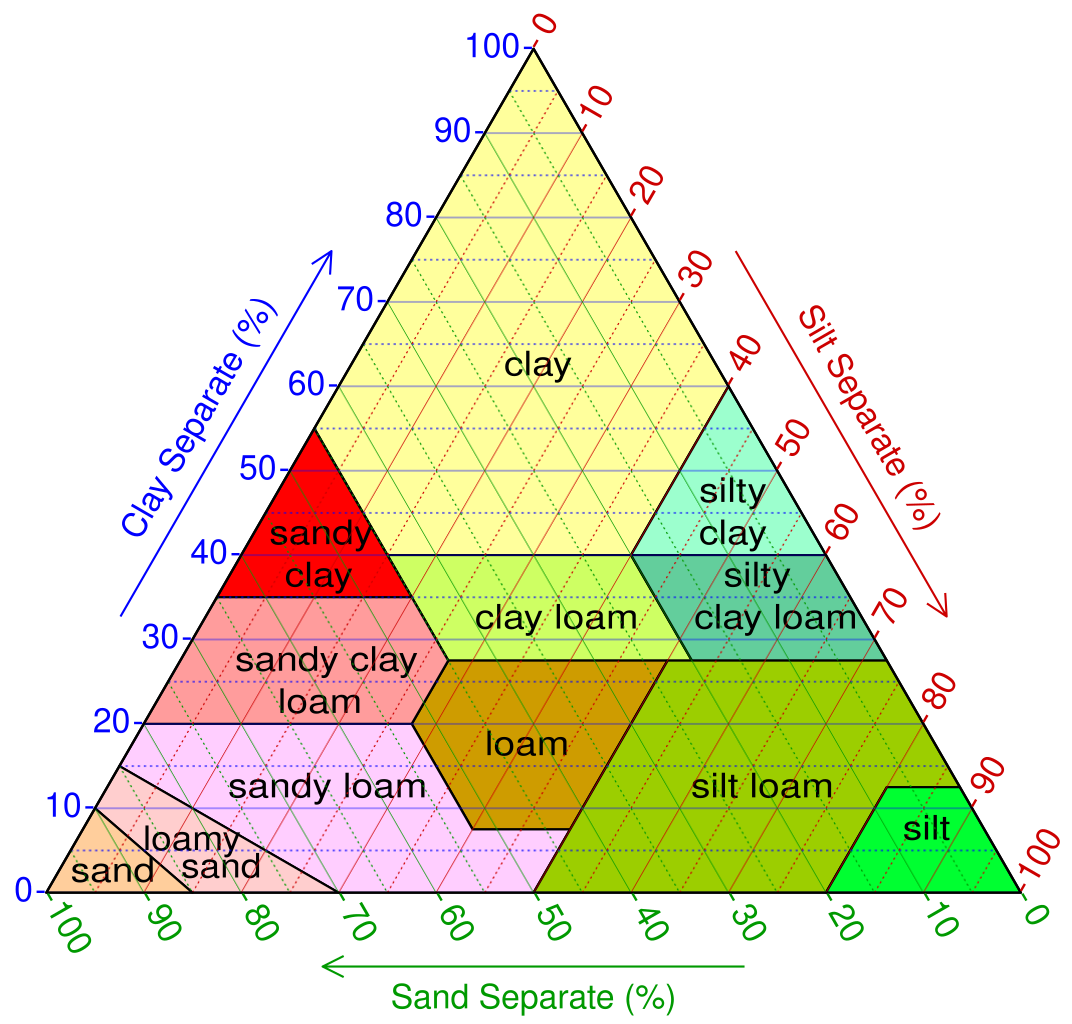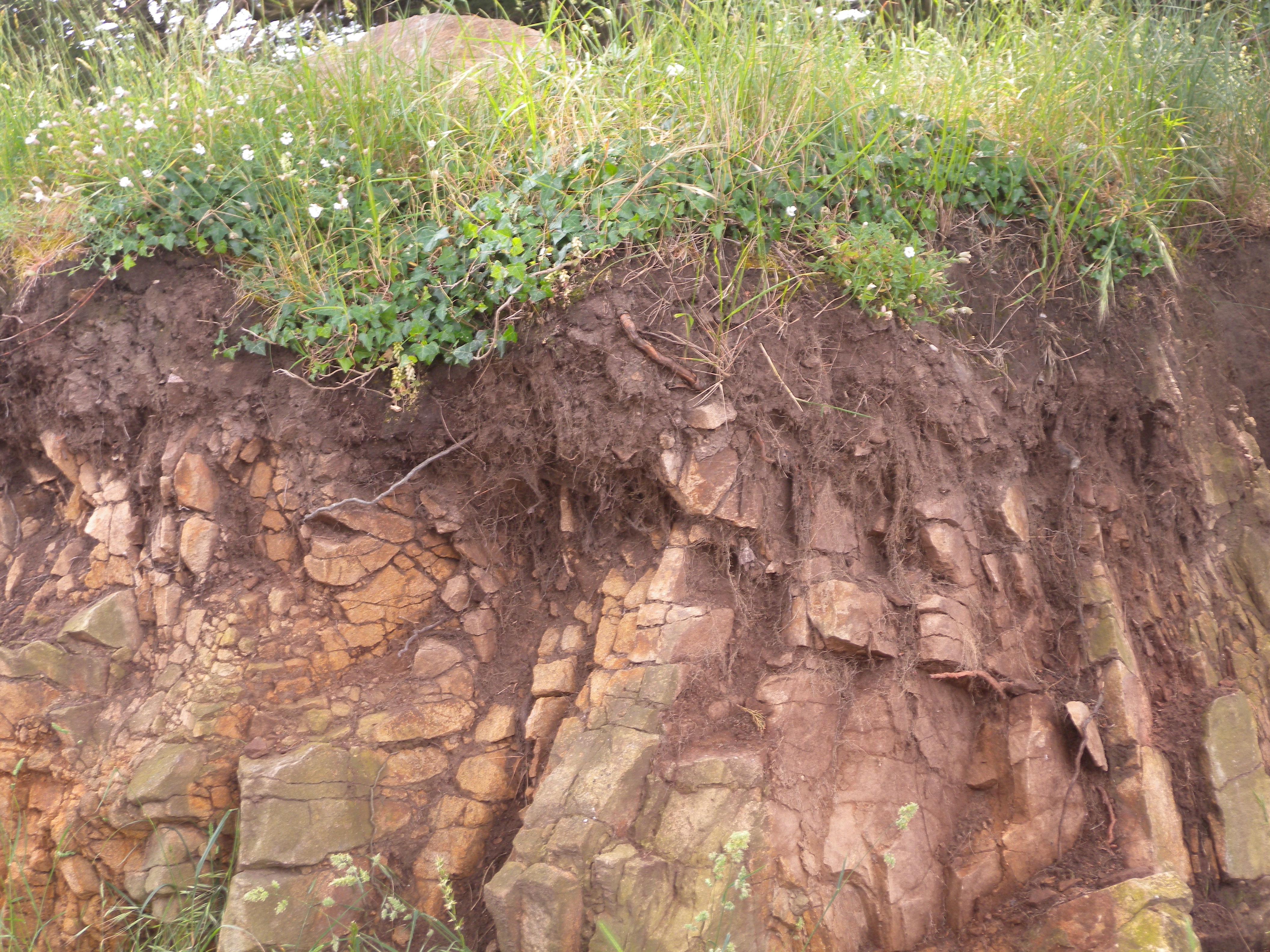Weathering, Erosion, and Deposition
5.2 Formation of Soil
Soil is essential for life on Earth, as it supports plant growth and forms from weathering processes. However, not all loose materials on the surface of the Earth are soils. Geographers define soil as the organic-rich layer that covers the top several tens of centimeters of the ground. Soil is complex, consisting of about 45 percent minerals, 5 percent organic matter, and 50 percent empty space that can be filled with air or water. The minerals in soil vary, but they mainly include clay minerals, quartz, feldspar, and rock fragments. The weathering processes in a region affect the soil’s type and amount of minerals. For instance, clay minerals are more common in soils that form in warm climates where chemical weathering is more intense. Soil texture depends on the soil’s relative amounts of sand, silt, and clay. These components differ in particle size, with sand and silt mostly quartz, feldspar, and rock fragments and clay mostly clay minerals.
Soil formation involves the accumulation and decomposition of organic matter and rocks’ mechanical and chemical weathering. Several factors influence the characteristics and rate of soil formation, such as climate (especially temperature and precipitation, which affect vegetation types), parent material (the original rock that weathers to form soil), slope (the angle of the ground surface), and time (the duration of soil development).
Formation of Soil
Climate
Soils develop because of the weathering of materials on Earth’s surface, including the mechanical breakup of rocks, and the chemical weathering of minerals. The downward percolation of water facilitates soil development. Soil forms most readily under temperate to tropical conditions (not cold), and precipitation amounts are moderate (not dry, but not too wet). Chemical weathering reactions (especially the formation of clay minerals) and biochemical reactions proceed fastest under warm conditions, and plant growth is enhanced in warm climates. Too much water (e.g., in rainforests) can lead to the leaching of critical chemical nutrients and, hence, acidic soils. In humid and poorly drained regions, swampy conditions may prevail, producing soil that is dominated by organic matter. Too little water (e.g., in deserts and semi-deserts), results in minimal downward chemical transportation and the accumulation of salts and carbonate minerals (e.g., calcite) from upward-moving water. Soils in dry regions also suffer from a lack of organic material.
Parent Material
Soil parent materials can include all different bedrock types and any unconsolidated sediments, such as glacial deposits and stream deposits. Soils are described as residual soils if they develop on bedrock, and transported soils if they develop on transported material such as glacial sediments. However, the term “transported soil” is misleading because it implies that the soil itself has been transported, which is not the case. When referring to such soil, it is better to be specific and say “soil developed on unconsolidated material,” because that distinguishes it from soil developed on bedrock.
Parent materials provide essential nutrients to residual soils. For example, a minor constituent of granitic rocks is the calcium-phosphate mineral apatite, which is a source of the critical soil nutrient phosphorus. Basaltic parent material tends to generate very fertile soils because it also provides phosphorus, along with significant amounts of iron, magnesium, and calcium.
Some unconsolidated materials, such as river-flood deposits, make for especially good soils because they tend to be rich in clay minerals. Clay minerals have large surface areas with negative charges that are attractive to positively charged elements like calcium, magnesium, iron, and potassium, which are essential nutrients for plant growth.

Slope
Soil can only develop where surface materials remain in place and are not frequently moved away by mass wasting. Soils cannot develop where the rate of soil formation is less than the rate of erosion, so steep slopes tend to have little or no soil.
Time
Even under ideal conditions, soil takes thousands of years to develop. Virtually all of northern North America was still glaciated up until 14 ka. Glaciers still dominated the central and northern parts of Canada until around 10 ka, and so, at that time, conditions were still not ideal for soil development even in the southern regions. Therefore, soils in Canada, and especially in central and northern Canada, are relatively young and not well developed.
The same applies to soils forming on newly created surfaces, such as recent deltas or sandbars, or in areas of mass wasting.
Soil Horizons
The process of soil formation generally involves the downward movement of clay, water, and dissolved ions, and a typical result of that is the development of chemically and texturally different layers known as soil horizons. The typically developed soil horizons are:
- O — the layer of organic matter
- A — the layer of partially decayed organic matter mixed with mineral material
- E— the eluviated (leached) layer from which some of the clay and iron have been removed to create a pale layer that may be sandier than the other layers
- B — the layer of accumulation of clay, iron, and other elements from the overlying soil
- C — the layer of incomplete weathering

Another type of layer develops in hot, arid regions known as caliche (pronounced ca-lee-chee). It forms from the downward (or in some cases upward) movement of calcium ions, and the precipitation of calcite within the soil. When well developed, caliche cements the surrounding material together to form a layer that has the consistency of concrete.
Like all geological materials, soil is subject to erosion, although, under natural conditions on gentle slopes, the rate of soil formation either balances or exceeds the rate of erosion. Human practices related to forestry and agriculture have significantly upset this balance.

Soils are held in place by vegetation. When vegetation is removed, either through cutting trees or routinely harvesting crops and tilling the soil, that protection is either temporarily or permanently lost. The primary agents of the erosion of unprotected soil are water and wind.
Soil is an important reservoir for organic components necessary for plants, animals, and microorganisms to live. The organic component of soil, called humus, is a rich source of bioavailable nitrogen. Nitrogen is the most common element in the atmosphere, but it exists in a form most life forms are unable to use. Special bacteria found only in soil provide most nitrogen compounds that are usable, bioavailable, by life forms.
These nitrogen-fixing bacteria absorb nitrogen from the atmosphere and convert it into nitrogen compounds. These compounds are absorbed by plants and used to make DNA, amino acids, and enzymes. Animals obtain bioavailable nitrogen by eating plants, and this is the source of most of the nitrogen used by life. That nitrogen is an essential component of proteins and DNA. Soils range from poor to rich, depending on the amount of humus they contain. Soil productivity is determined by water and nutrient content. Freshly created volcanic soils, called andisols, and clay-rich soils that hold nutrients and water are examples of productive soils.
Water erosion is accentuated on sloped surfaces because fast-flowing water has higher eroding power than still water. Raindrops can disaggregate exposed soil particles, putting the finer material (e.g., clays) into suspension in the water. Sheetwash, unchannelled flow across a surface carries suspended material away, and channels erode right through the soil layer, removing both fine and coarse material.
Wind erosion is exacerbated by the removal of trees that act as windbreaks and by agricultural practices that leave bare soil exposed.
Tillage is also a factor in soil erosion, especially on slopes, because each time a cultivator lifts the soil, it is moved a few centimeters down the slope.
Weathering and Climate Change
Earth has two important carbon cycles. One is the biological one, wherein living organisms, mostly plants, consume carbon dioxide from the atmosphere to make their tissues, and then, after they die, that carbon is released back into the atmosphere when they decay over years or decades. A small proportion of this biological-cycle carbon becomes buried in sedimentary rocks: during the slow formation of coal, as tiny fragments and molecules in organic-rich shale, and as the shells and other parts of marine organisms in limestone. This becomes part of the geological carbon cycle, a cycle that involves a majority of Earth’s carbon but operates only very slowly.
The geological carbon cycle below shows the various steps in the process (not necessarily in this order):
- Organic matter from plants is stored in peat, coal, and permafrost for thousands to millions of years.
- Weathering of silicate minerals converts atmospheric carbon dioxide to dissolved bicarbonate, stored in the oceans for thousands to tens of thousands of years.
- Marine organisms convert dissolved carbon to calcite, which is stored in carbonate rocks for tens to hundreds of millions of years.
- Carbon compounds are stored in sediments for tens to hundreds of millions of years; some end up in petroleum deposits.
- Carbon-bearing sediments are transferred to the mantle, where the carbon may be stored for tens of millions to billions of years.
- During volcanic eruptions, carbon dioxide is released back to the atmosphere, where it is stored for years to decades.
During much of Earth’s history, the geological carbon cycle has been balanced, with carbon being released by volcanism at approximately the same rate that the other processes store it. Under these conditions, the climate remains relatively stable.
During some periods of Earth’s history, that balance has been upset. This can happen during prolonged periods of higher than average volcanism. One example is the eruption of the Siberian Traps at around 250 Ma, which appears to have led to strong climate warming over a few million years.
A carbon imbalance is also associated with significant mountain-building events. For example, the Himalayan Range was formed between about 40 and 10 million years ago. Over that period, and still today, the rate of weathering on Earth has been enhanced because those mountains are so high, and the range is so extensive. The weathering of these rocks, most importantly the hydrolysis of feldspar, has resulted in the consumption of atmospheric carbon dioxide and transfer of the carbon to the oceans and ocean-floor carbonate minerals. The steady drop in carbon dioxide levels over the past 40 million years, which led to the Pleistocene glaciations, is partly attributable to the Himalayan Range formation.
Another, non-geological form of carbon-cycle imbalance is happening today on a very rapid time scale. We are in the process of extracting vast volumes of fossil fuels (coal, oil, and gas) that were stored in rocks over the past several hundred million years, and converting these fuels to energy and carbon dioxide. By doing so, we are changing the climate faster than has ever happened in the past.

